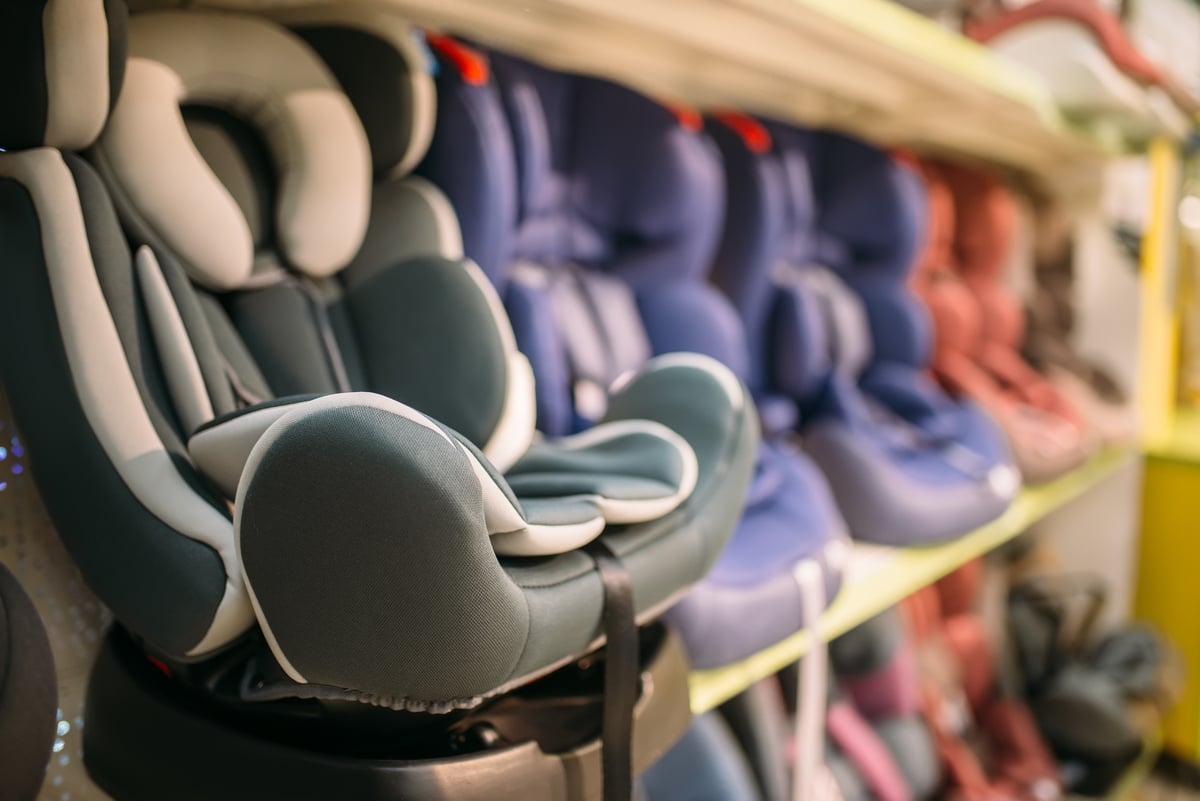As your baby grows, you may need to move them from an infant car seat to a toddler or convertible car seat. But when is your baby too big for an infant car seat? How do you know when it’s time to move on to a bigger seat? As well as the weight limit for infant car seats, there are a few other things to keep in mind when making the switch. Keep reading to learn more.
Infant car seats should be used for babies who weigh between 22 to 35 pounds. Once your baby outgrows their infant car seat, they can use a convertible car seat in the rear-facing position until they reach the weight or height limit for that seat. To use the car seats for your baby, you’ll need to purchase a car seat that’s appropriate for their weight, height, and age.
If your child has outgrown their car seat, you can use a booster seat to help them ride safely in the car. Booster seats are designed for children who have outgrown their car seats but are not yet big enough to ride safely without one. Booster seats must be used with a lap and shoulder belt. With a booster seat, a child who has outgrown their car seat can still ride safely in the vehicle. But when is the appropriate time to move from an infant car seat to a convertible? Here is everything we’ve outlined related to the context, so scroll down.
In This Article
When babies are too big for Infant car seats?
Usually, infant car seats are meant for babies who weigh up to 22 pounds. So if your baby is heavier than that, you’ll need to switch to a bigger car seat. In other words, parents who use an infant seat usually transition to a larger, convertible seat between 9 months and 2 years of age, depending on their child’s size but they may do so sooner if the seat is certified safe for their babies height and weight.
Most experts recommend that infants ride rear-facing until they are at least 2 years old or until they reach the maximum height and weight limits for their car seat. You can find these limits in your car seat’s owner’s manual. Once your child has outgrown their rear-facing car seat, they can ride in a forward-facing car seat with a harness. For a child, forward-facing, the top of their head must be at least 1 inch below the top of the seat belt. Similarly, for a rear-facing only, the child’s ear must be at least level with the top of the seat belt.
Children should stay in a forward-facing car seat with a harness until they reach the maximum height and weight for that seat. After that, they can use a belt-positioning booster seat until the adult belt fits them correctly.
Finally, once they have outgrown the booster seat, they can ride using only the adult seat belt if it fits correctly. The shoulder strap should rest across the middle of their chest, and the lap belt should fit snugly across their upper thighs. If the seat belt doesn’t fit correctly, they should continue to use a booster seat. So, if your baby has outgrown either the height or weight limit for their seat, it’s time to move on to the next type of car seat.
What is the difference between an infant and a convertible car seat?
Infant car seats are designed for newborns and young infants, while convertible car seats can be used for both newborns and toddlers.
An infant car seat is designed to be used rear-facing and has a harness that goes around your baby’s body. A convertible car seat can be used both rear-facing and forward-facing and has a harness that goes around your child’s body.
The convertible is bigger in size, so an infant car seat would be outgrown sooner. An average baby reaches the height or weight limit of an infant car seat by 8 to 10 months old, so you’ll need to switch to a convertible car seat at that point. There are some things to keep in mind when using a convertible car seat:
-When using the seat rear-facing, make sure that the harness is at or below your baby’s shoulders.
-When using the seat forward-facing, make sure that the harness is at or above your child’s shoulders.
-Make sure that the car seat is installed according to the manufacturer’s instructions.
Furthermore, switching infants to convertible car seats, you need to know the basic types of convertible car seats. Always remember that the safest place for your child’s car seat is in the back seat. Moreover, you should always consult your pediatrician before making the switch from an infant car seat to a convertible car seat.
What are the benefits of using babies’ car seats?
Car seats for your child offer many benefits that you may not be aware of. In addition to keeping your little one safe while on the road, infant car seats can also provide a number of developmental advantages for your child. As well as a car seat and travel safety, here are some of the benefits that you may not have considered {1}.
1. Provide protection
In the event of an accident, an infant car seat can help to protect your baby from serious injury. The top of the car seat is designed to support your baby’s head and neck, while the padded sides can help to protect their fragile body from being jolted around too much.
2. Support development
If your child is under six months old, they will need to lie in a semi-reclined position when traveling in a car seat. This is especially important for preemies or children who were born early. The infant seat in the car can help to position your child in a way that is comfortable and safe for them and can also help to support their head and neck as they grow.
3. Help them to feel secure
For a baby, being in a car can be a very overwhelming experience. The constant movement and noise can be quite disorienting and can cause them to feel anxious or stressed. Having their own space in an infant car seat can help to give your baby a sense of security and comfort while on the road.
4. Encourage sleep
The seat in the car can help to encourage your child to sleep. This is because the rocking motion of the car can help to lull your child to sleep. The car seat can also provide a comfortable and safe place for your child to sleep, which can help to promote better sleep for both you and your child.
5. Promote bonding
The close contact that you have with your child when they are in an infant car seat can help to promote bonding. This is because you are able to talk to them and interact with them while they are in their seat. You can also give them a hug or a kiss when they are in the car seat, which can help to build a strong bond between you and your child.
6. Convenience
An infant car seat can be a convenient option because it allows you to transport your child without having to wake them up. You can also use the car seat as a travel bed for your child when you support their spine and head. This is especially important for premature babies or those who were born with low birth weight.
At what age do you switch to a convertible car seat?
It really depends on the height and weight of your child. Most convertible car seats have a weight limit of about 65 lbs, but you’ll want to check the specifications of your particular seat. The general rule of thumb is to switch to a convertible car seat when your child reaches the height or weight limit for their forward-facing seat.
Many parents switch to a convertible car seat when their child is around two years old, but it’s really up to you and your child’s needs. Remember that it’s always better to keep your child in a car seat for as long as possible, even if they’ve reached the weight or height limit, since they may still be small for their age. So consult with your pediatrician and trusted car-seat experts to figure out what’s best for your baby.
Can a 4-month-old use a rear-facing convertible car seat?
Absolutely! Your four-month-old can (and should) continue to ride rear-facing in a convertible car seat. In fact, it is recommended that infants and toddlers ride rear-facing as long as possible, up to the highest weight or height allowed by their car seat manufacturer {2}.
Convertible seats can be used in the rear-facing position from birth until your child reaches the maximum weight or height limit for that particular seat. Most convertible seats have higher height and weight limits for the rear-facing position than they do for forward-facing, so you can usually keep your child rear-facing for a longer period of time if you have a convertible seat.
How long does my baby stay in an infant car seat?
It is recommended that a baby should not be in a car seat for longer than 2 hours. This is because car seats can restrict the baby’s blood flow and cause them to become fussy or even fall asleep. It is important to always check with your doctor to see what their recommendation is, as different babies may need different amounts of time in a car seat.
When can a baby go in a baby seat?
Most babies are ready to ride in a baby seat between 4 and 6 months old.
Some babies may be ready earlier, others later, but it’s generally advised not to wait too long. Around 4-6 months old, a baby has generally developed the neck and head control needed to sit up safely in a baby seat. And by that age, most babies are also eating solid foods, so they’re less likely to choke while in the seat.
It’s important to always follow the manufacturer’s instructions for use with any child safety product. And if you have any questions or concerns, always consult your pediatrician.
The Bottom Line
So, car seats for infants are great for keeping your baby safe and comfortable while you’re on the go. But, as your baby grows, he or she will eventually outgrow the infant car seat. Always make sure of the seat belt of the vehicle to keep the child secure in case of an emergency stop. The best way to know when your baby has outgrown his or her infant car seat is to consult the car seat’s owner’s manual or contact the car seat manufacturer. Also, be sure to keep your child rear-facing as long as possible, as this is the safest position for young passengers. We hope this article was helpful for you and your family. If you have any queries please let us know in the comments section below. Thank you for reading!








![Home Renovation Guide [2025]](/app/uploads/2021/04/design-hacks-1-378x300.jpg)


